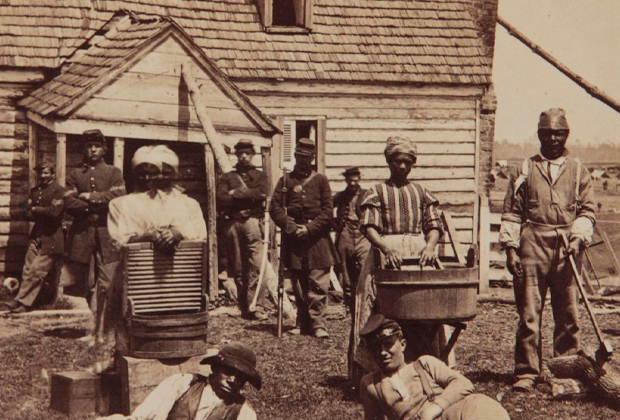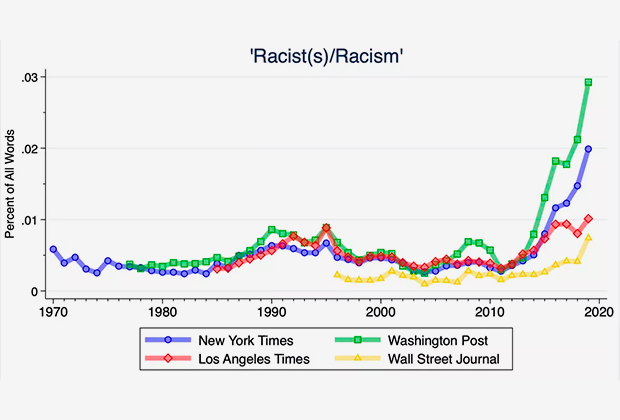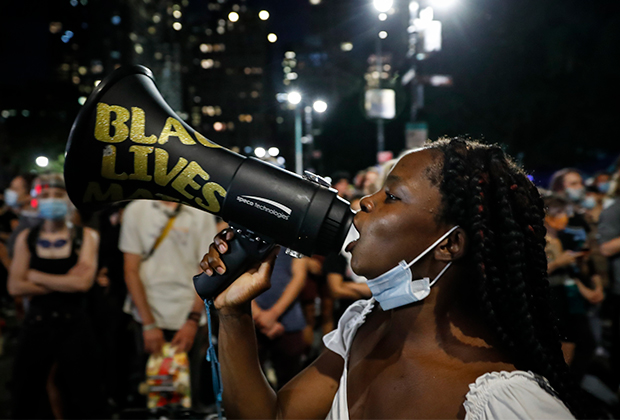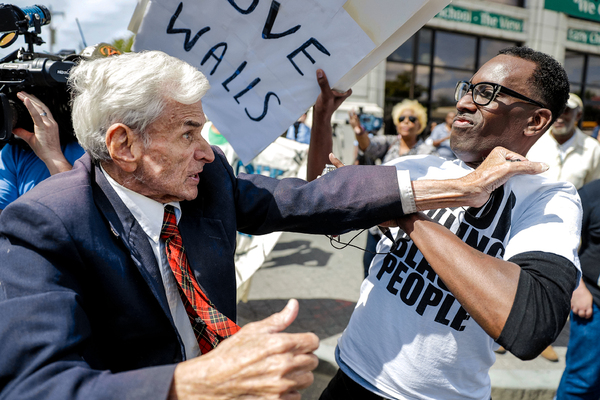Americans are trying to eradicate racism. Why does this make it difficult for whites to live in the United States?
Centuries of slavery, apartheid laws, lynching and discrimination – the United States cannot forget its racist past. And although the struggle for civil rights left segregation in the past, many Americans are convinced that racism still lives on even in those who would not even dream of setting fire to crosses in white robes. How to squeeze the hated racist out of oneself, no one really knows, but the absence of an understandable enemy is not a reason to stop fighting. And now the fighters for racial equality are directing their anger not at radicals or even at white people, but at their very “whiteness” – an abstract quality that defines them as a community of oppressors. We figured out where the new ethics of racial relations came from, why all whites are called racists, and what role Lenin played in the formation of these ideas.
Don’t be white if possible
Moderate confidence in yourself and your words, be less arrogant and ignorant, less defend your position. Be more modest, listen more to others, trust more. And please, no solidarity with representatives of your ethnic group. All this, according to the authors of the training course for Coca-Cola employees, means “being less white”.
“Try to be less white” – such an inscription in large print flaunted on the main slide of the presentation
The same course says that understanding and accepting what it really means to be white is a step towards overcoming prejudice and defeating racism. The system of racial inequality, the authors argue, is supported even by children: in Western countries, from the age of 3-4, they begin to understand that it is better to be white than colored. At least, this is the conclusion that researchers come to.
One of the Coca-Cola employees leaked screenshots of this presentation to social networks, and this caused a wave of outrage. For many, the ideas of this course have become an obvious manifestation of racism – after all, if you replace the words “white” with “black” in them, you get phrases for which in the modern USA or Great Britain you can easily lose your job, or even be prosecuted.
Representatives of Coca-Cola spoke publicly after a couple of days of heated discussion in the media – while without any apologies for the racism of which they were accused. They explained that the course was not required for all employees, but served as only one of the educational elements. It was intended to form an inclusive, that is, open to all, working space. In addition, the Coca-Cola statement indicates that the course was not developed specifically for their company: it is made at the Big Think education center and is hosted on the LinkedIn business platform for use by any employer who wants to.

Calls for a boycott of Coca-Cola products have already been heard online, when coach and blogger Karlin Borisenko, thanks to whom the world learned about this “racial training”, spoke out against discrimination against the carbonated drink. In her opinion, the public should condemn and persecute not the company, but those who created the training.
The anonymous authors relied on the work of sociologist Robin Joan DiAngelo. And although she herself disowned her involvement in the scandalous training, his concept as a whole does not contradict her views. DiAngelo has devoted her entire scientific career to such a controversial field as whiteness studies. This branch of social science, the name of which can be translated as “research of whiteness”, has existed for several decades.
Life with a clean slate
Most of the scientific disciplines that study the ethnic groups of the United States and other countries differ in their approaches from whiteness studies. Studies of blacks, Hispanics, Asians, indigenous peoples by default relate to their subject without emotional or ideological connotations: they are simply areas of sociology that study certain groups of the population.
With studies of “white-skinned” things are different: at the origins of this direction of racial theory are authors whose goal was to expose injustice and defeat the “white supremacy” that has been established in the world – primarily in the United States. This vision of the problem has long been entrenched as the ideological mainstream of the “left” wing of American politics.
White researchers these days are attacking the phenomenon of latent racism. They argue that not only those who despise and hate people because of their skin color are involved in racial oppression – on the contrary, “good”, well-meaning people are involved in maintaining racism. In their understanding, almost every element of public life supports the oppression of ethnic minorities.
In the video lecture “Deconstructing White Skin,” Robin DiAngelo effectively deprives white people of the opportunity to claim that they are not racist. According to her, every white person from the earliest years absorbs unconscious racist attitudes from his environment, and he needs to realize and accept this. But at the moment of collision with this reality, the white person begins to defend himself – he shows what DiAngelo calls “white fragility.”
I help white people understand that racism is the very fabric of which our society is made. Robin DiAngelo
sociologist
Certainly “racist” in this paradigm are, among other things, statements like “I don’t divide people by skin color”, “For me all races are the same”, any denial of my own racism, as well as all kinds of religious views preaching universal equality. It is believed that such a condescending attitude can only be afforded by representatives of the dominant white race – the rest are primarily determined by skin color, and they cannot do anything about it.
The same is true for less obvious things. For example, individualism can be attributed to a manifestation of racism: a white person who claims that he achieved everything himself and that the course of his life depends on him personally, thus denying the privileges of the ethnic majority and contributes to the prosperity of the racist system.
Minorities existing in it – first of all, blacks – are constantly exposed to “microaggression” from all sides: almost every aspect of their life, from mentality and culture to gait, clothing, intonation and vocabulary, is perceived worse than the same among whites. “White” is defined, among other things, as the dominant norm, invisible and convenient for its carriers – but painful for those who do not fit into it.
White on black
The assumption of any differences between human races (other than the obvious anthropological ones) is certainly rejected by modern science. It is unacceptable to consider such issues seriously and even to discuss, and in humanitarian circles it is postulated that the origin cannot play a significant role.
Race is viewed exclusively as a social construct and is often even quoted to show the artificiality of this concept.
Even the moment when it was constructed is recorded. And it, like any ideological superstructure, is ascribed its own material and economic base – in strict accordance with Marxist dogmas. Theodore Allen, one of the key authors in this area, pointed out in his book The Invention of the White Race that as far back as the 18th century there were no reports of white workers’ hostility towards blacks.
In his opinion, skin color did not matter much in public relations, and then ideas about races drew clear boundaries between ethnic groups: for example, the Celts, Saxons and Irish were attributed fundamentally different qualities from each other, which “confirmed” the measurements of the skulls. The racial theory that belittled blacks in the eyes of others was already unfolding in the 19th century.
Racial hatred, in his opinion, was kindled in the USA by white bourgeois – planters who did not want to unite workers with different skin colors against the power of capital
Researchers “whiteness” believe that this was the beginning of the history of a single North American identity and modern understanding of race. Small, fair-skinned peoples, who until this demarcation were considered second-class groups – Irish, Italians, Jews, and others – rapidly merged into a single community of “Americans” and supported the Democratic Party, which then advocated the preservation of slavery for blacks.
Researchers call this process nothing more than mass class betrayal. Now there is a different term for non-white conservatives and Trumpists: they are accused of “interracial whiteness” – the desire to become part of an aggressive, dominant system, forcing them to forget about their roots.

In the 19th century, immigrants from all European countries were sent to the “melting pot” of the American nation. As a result, as the socialist sociologist Charles Gallagher emphasizes, for a white American, his ethnic roots are nothing more than “personal orientation, something like a hobby, the references to which bring joy.” The white person, as a rule, is not bound by the boundaries of this identity and can abandon it, classifying himself simply as a nation of Americans. He achieves his goals much easier, taking advantage of the unconditional disposition of others, even if he does not notice it – this is how “white privileges” work.
A black man is constantly seen as a representative of a particular group. At the same time, every social interaction is permeated with a prejudice against minorities – and life in a racist society for them turns out to be a constant stream of “micro-aggression”, hidden and half-hidden manifestations of hostility and contempt. And neither the freeing of slaves, nor the abolition of segregation has corrected this problem.
To the ground, and then …
The distinction between pride in “theirs” in a large and small community was drawn by Vladimir Lenin. He wrote about this in 1922, urging to distinguish the pride of the oppressor from the pride of the oppressed. Even then, he noted the absolute importance of “micro-aggression”.
We, the nationals of a large nation, find ourselves guilty of an infinite amount of violence, and even more than that, we unnoticeably commit an infinite number of violence and insults, (…) therefore internationalism from the oppressive or so-called “great” nation (although great only by our own violence, great only as the great derzhimorda) must consist (…) in such inequality that would compensate on the part of the oppressing nation, the big nation, the inequality that develops in life in fact
Vladimir Ulyanov-Lenin
Marxist philosopher, head of the government of the USSR
His ideological cousins - the American communists and socialists – carried such a philosophy onto their own soil as early as the 1960s, during the surge in the human rights movement. They sided with the protesting blacks along with some Christians and followers of Judaism and were not afraid to ironically call themselves “traitors to the race.”
Then, during the Cold War, openly Marxist movements could not become the political mainstream – for most Americans, Marxism-Leninism, the basis of the national and foreign policy of the USSR, was the ideology of irreconcilable enemies of everything that was dear to them. On the whole, they were not wrong, and this is the case until now. But several decades passed, the red empire collapsed, and the Marxists of the 60s unrestrainedly got up to the pulpits to carry the “Leninist” understanding of justice to their students.
Anti-racism from the cradle
In the second decade of the 21st century, the fruits of “educational” work became especially noticeable: what happened in the media is the “great racial awakening.” Since about 2010, the frequency of the use of almost all vocabulary related to problems of racism has steadily increased in the largest American media. The phrases “systemic racism,” “white people,” “racial privilege,” “communities of color,” and just about any other keywords for this topic have come to be used several times more often.

It can be considered that the media or left-wing academics played the main role in what is happening – it will be difficult to choose any one reason here. One thing is clear: a socialist view of racial justice is now the norm for a significant number of Americans. Until 15 years ago, only about one in three white Democratic supporters considered racism to be an important issue for the country. Now this number exceeds 80 percent, and the centrists are gradually agreeing with this position.
Universities and colleges generally agree on unconditional shame for the white past and are debating which of the “dead white men” to remove from the curriculum next. The word “white” has become so abusive on campuses that it is considered a hate crime to put up posters with the words “To be white – okay”.
Meanwhile, the fight for justice is spreading to schools – affecting both expensive private institutions and special programs for high-performing children. For example, an advanced classroom that has too many whites and Asians on examinations may be disbanded due to inequality.
Even many parents of “leftist” views are perplexed when faced with the latest agenda: “They make my son feel racist – just because of the color of his skin,” the mother of a private school student shared with the journalist. Another explained why none of the parents would speak openly to the press.
The school will ask you to pick up the documents, and then you will find yourself on the blacklists of all private schools – they will know you as a racist, and this is worse than a murder charge
the mother of a private school student who wishes to remain anonymous
The same is true in other areas – and unhappy white Americans can only speak anonymously, although more than half of them, 55 percent, believe in discrimination on the basis of white skin color. “Qualification doesn’t play such a role these days as gender and skin color,” the 47-year-old engineer complained to reporters. His remark, as usual in the media, illustrated the text about how white people do not understand the essence of oppression.
In the school years, the struggle does not stop and goes on, affecting very early childhood. For example, the Arizona Department of Education has issued a flyer mentioning racism in infants. It says that babies have a preference for people of their color from the age of three months, and parents should take steps to raise children “anti-racists”, even before they begin to walk and talk.
State institutions are also involved in the “racial awakening”. So, American President Joe Biden, introducing support measures against the backdrop of the coronavirus pandemic, announced that the priority for receiving money is representatives of minorities.
State aid is not limited to quotas on blacks, a lowered standard of admission to universities for them, and “positive discrimination” in the workplace (the principle of giving preference to a minority, all other things being equal) – it also helps with the promotion of ideas. Every February, the United States celebrates Black History Month, and a thematic museum in the heart of Washington DC distributes Robin DiAngelo’s video about white fragility on its home page.
The racial theme experienced an even more dramatic rise after the death of black George Floyd due to the actions of the police during the arrest. The demonstrations organized by the Marxists from Black Lives Matter were arguably the largest in the country’s history, and footage of pogroms and robberies spread around the world.
After that, they started talking about perhaps the most daring hope of fighters for equality – reparations for the entire black population.
This idea could often be found on the banners of BLM supporters, it was seriously discussed in the primaries of candidates from the Democratic Party, even former US President Barack Obama spoke in support of such a measure. As it became known in early March, Biden’s adviser Cedric Richmond is actively developing the issue of reparations in his work. His first steps towards overcoming “systemic racism” included free tuition in “historically African American colleges” and “affirmative action” against whites in government programs to help buy housing.
At the same time, Richmond does not intend to wait until scientists confirm the correctness of such steps. “We will not wait for research. We will act now, ”he said speaking on television.
No one will give us redemption
All the existing “bonuses” provided to the black population have not eradicated the real inequality – and it is unclear exactly when to expect it to disappear. When will European Americans be able to rectify the situation and atone for their guilt? If you look at the situation through the lens of whiteness studies, then a completely reasonable answer to this question may be “never”.

As the classical Marxist theory of our time, “studies of whiteness” see an abstract outcome in the abstract future – the overthrow of white privileges and the reign of “justice”. Unlike the socialists of the 20th century, modern Marxists do not hope for the help of the white working class – already in the 1980s under President Ronald Reagan it became clear that he liked “right” economic policy too much, and he did not particularly care about the problems of minorities.
“It is necessary to get rid of whiteness” – this slogan, popular among activists, indicates the ultimate goal of the struggle. It is the minorities that thus find themselves in the place of the “exploited” class, which will certainly defeat the “exploiters”. But the distance to triumph always remains unknown.
How Soviet communist ideology resembles religious doctrine has been pointed out more than once. The same can be said about the views of Lenin’s contemporary “heirs”. In addition to the “end times” motive, there are other aspects of critical theory that indicate its great similarity with religiosity. As publicist Barbara Kay has emphasized, the concept of “innate racism” of white Americans is in many ways reminiscent of biblical motives.
If you are white, then you are branded – literally in your flesh, evidence of a kind of original sin. You can try to mitigate the evil that is in you, but you cannot eliminate it. The goal (…) in introducing racial thinking everywhere – eternal sacrifice for non-whites, eternal shame for whites. Barbara Kay
publicist
Following the media, government and activists, business is expected to pull up to propaganda – and for those who would like to boycott Coca-Cola because of its love for social justice, it is hardly suitable to switch to Pepsi. Ramon Laguarta, CEO of PepsiCo, said his company is “proud to support” BLM’s slogans and will commit more than $ 400 million over the coming years to black communities, entrepreneurs, and “systemic racism.” The firm will also increase the number of black executives by 30 percent.
It would be an exaggeration to say that the United States is completely under the control of Marxist theories: almost one in two Americans in the 2020 elections voted for Republican Donald Trump, who is constantly accused of racism. However, the voices of BLM and their sympathizers are growing louder, and there are fewer and fewer life choices that do not involve the support of racial justice. And while the United States remains the global hegemon, the agenda popular on American soil affects the rest of the world.






